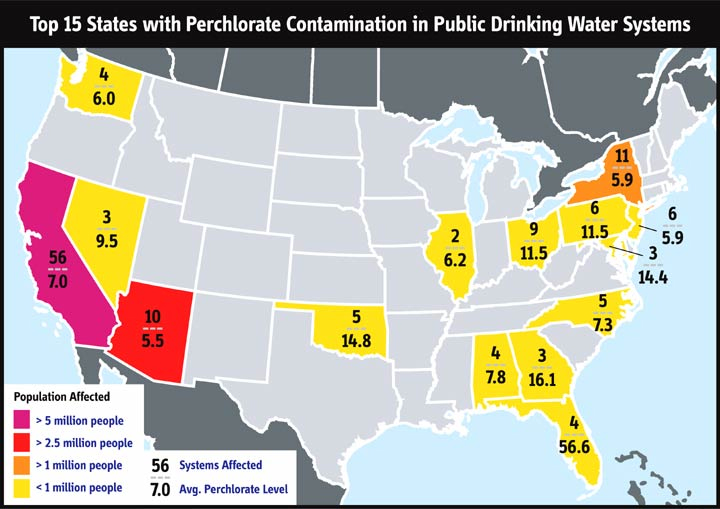Rocket Fuel Chemical Found in Breast Milk of Women in 18 States

Updated 3:38 p.m. ET
A toxic component of rocket fuel has been found in breast milk of women in 18 states and store-bought milk from various locations around the country.
The chemical, perchlorate, can impede adult metabolism and cause retardation in fetuses, among other things. It leaches into groundwater from various military facilities.
Previous studies have found perchlorate in drinking water, on lettuce, and in cows milk.
The new research, announced this week, suggests perchlorate is a bigger problem than thought, scientists said.
Texas Tech University researchers studied 36 samples of breast milk from women in 18 states and 47 samples cow's milk purchased from stores in 11 states. Every sample of breast milk contained perchlorate, as did all but one sample of dairy milk.
The highest levels were found in women from New Jersey, New Mexico, Missouri, Nebraska and California, in that order.
Get the world’s most fascinating discoveries delivered straight to your inbox.
The results are detailed in the online version of Environmental Science & Technology, a journal of the American Chemical Society. The work was led by Texas Tech biochemist Purnendu Dasgupta.
"We've got to come to grips with the perchlorate situation quickly,'' said California Senator Dianne Feinstein in a statement. "And EPA has to move quickly to set a national drinking water standard that protects the health and safety of all Americans.''
The details
Perchlorate occurs naturally and is also a primary ingredient in solid rocket fuel, munitions and fireworks. Perchlorate does not build up in human tissues over time, scientists say, but there has been speculation it could accumulate in breast milk.
In excess, the chemical can interfere with iodide uptake in the thyroid gland, disrupting adult metabolism and childhood development, scientists say.
In fetuses, it can potentially cause mental retardation, loss of hearing and speech, and motor skill deficits.
The average perchlorate concentration in breast milk samples was 10.5 micrograms per liter. The dairy milk average was 2.0 micrograms per liter. No definitive national standard exists, although the U.S. Environmental Protection Agency had suggested a limit of 1.0 micrograms per liter in drinking water.
The study also found that high levels of perchlorate in the breast milk samples were indeed related to low levels of iodide. Low iodide levels can inhibit thyroid function in nursing women. Scientists admit there is limited data, but Dasgupta and colleagues said the levels found in the study are "sufficiently low to be of concern."
They suggest that the recommended daily intake of iodine for pregnant and nursing women may need to be revised upward.
The report should not raise undue alarm, said Ed Urbansky, a former Environmental Protection Agency chemist who was not involved in the latest study.
"It's very difficult to determine what the findings might be other than to know it might be in so many milk samples,'' Urbansky said.
In your water
Perchlorate is in the drinking water of at least 11 million U.S. residents, other research has shown. The chemical is present in the Colorado river, which provides water to Los Angeles, Phoenix and Las Vegas and is used to irrigate 70 percent of the nation's lettuce crops, according to the Environmental Working Group, which studied the problem in 2003 in cooperation with scientists at Texas Tech.
An overview study of perchlorate released in January by the National Academies' National Research Council (NRC) tried to assess the risk, but scientists continue to argue about how much of the chemical is too much.
Also in January, a study out of Russia claimed children near Kazakhstan's Baikonur Cosmodrome, where rockets are launched, are twice as likely to require medical attention as other children in the region.
The Associated Press contributed to this story.
Robert is an independent health and science journalist and writer based in Phoenix, Arizona. He is a former editor-in-chief of Live Science with over 20 years of experience as a reporter and editor. He has worked on websites such as Space.com and Tom's Guide, and is a contributor on Medium, covering how we age and how to optimize the mind and body through time. He has a journalism degree from Humboldt State University in California.



